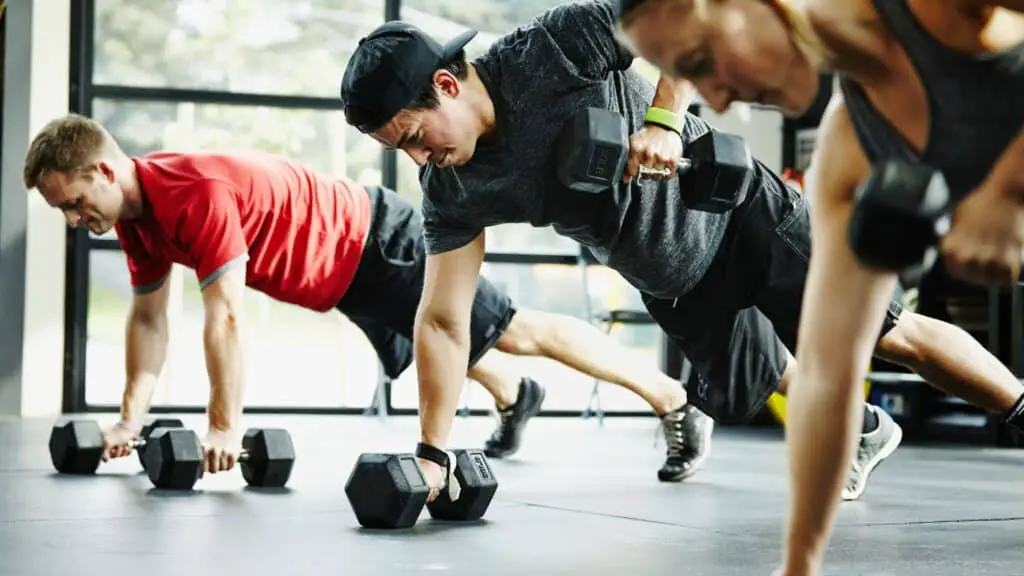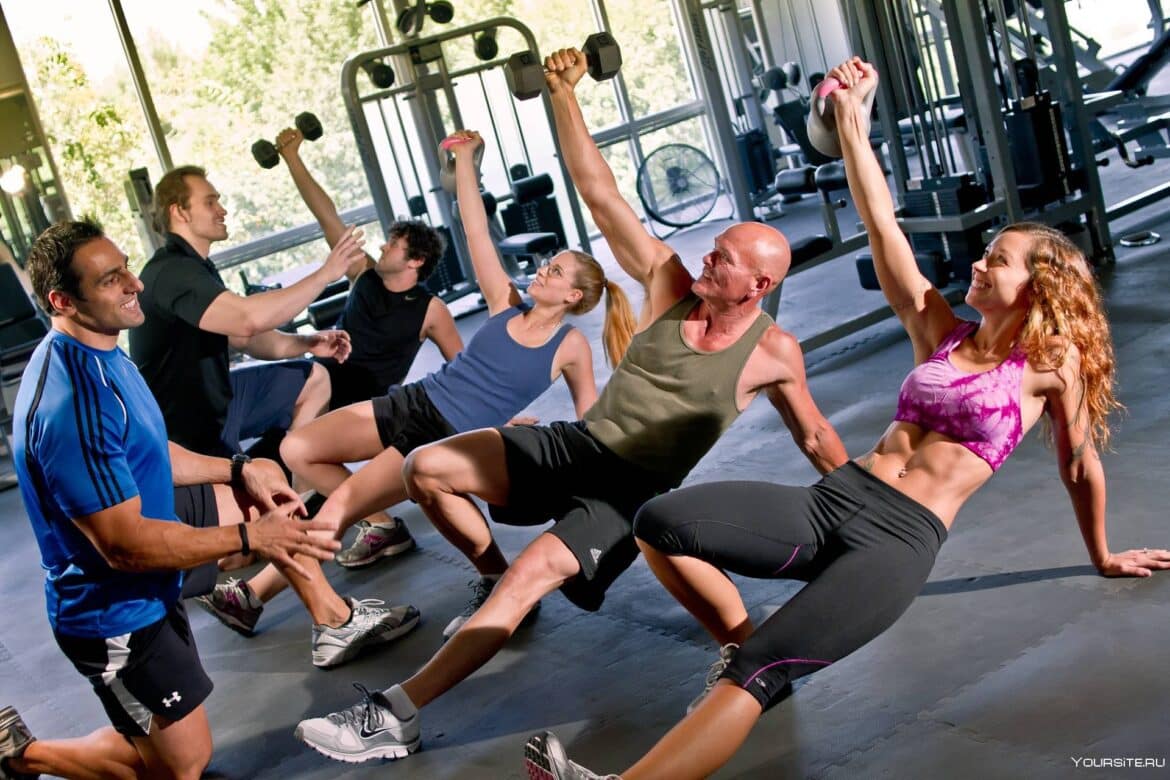Introduction
What Is Considered Functional Strength Training: Functional strength training is a dynamic and versatile approach to physical fitness that transcends traditional weightlifting and muscle-building routines. Unlike conventional strength training, which often focuses solely on isolating specific muscle groups, functional strength training places a premium on enhancing overall physical performance and functionality. It is a holistic training philosophy that aims to improve one’s ability to perform everyday activities and sports-related movements with greater ease, efficiency, and reduced risk of injury. This approach emphasizes the development of functional aerobics strength, agility, balance, and coordination, making it an essential component of a well-rounded fitness regimen for individuals of all ages and fitness levels. In this exploration, we will delve into the principles, benefits, and key components of functional strength training, shedding light on its significance in achieving a more functional and resilient body.
Functional strength training is rooted in the idea that fitness should go beyond mere aesthetics or the ability to lift heavy weights in a controlled gym environment. Instead, it seeks to improve the body’s capacity to perform real-world tasks effectively and safely. Whether it’s lifting groceries, playing sports, carrying children, or simply moving furniture, functional strength training equips individuals with the physical abilities needed to excel in their daily lives. This training methodology places a strong emphasis on compound movements that engage multiple muscle groups simultaneously, mimicking the demands of everyday activities. Exercises like squats, deadlifts, lunges, and various functional bodyweight movements are fundamental components of this approach. Additionally, functional strength training often incorporates elements of balance, stability, and mobility exercises to enhance overall physical functionality.
One of the most appealing aspects of functional strength training is its inclusivity. It can be tailored to suit the needs and goals of individuals at any fitness level, from beginners to elite athletes. Furthermore, it can be adapted for rehabilitation purposes, helping individuals recover from injuries or address imbalances in their bodies. In the following exploration of functional strength training, we will delve deeper into its key principles, exercises, training routines, and the multitude of benefits it offers. Whether you’re an athlete aiming to enhance sports performance or someone seeking to improve your day-to-day life, functional strength training offers a comprehensive and effective path to achieving your fitness goals. Functional strength training is not solely about building muscle mass; it’s about creating a strong, balanced, and adaptable body. It places a premium on functional fitness, which encompasses various physical attributes such as strength, endurance, flexibility, and coordination, all of which are essential for daily activities and athletic endeavors.

What is considered functional strength training on Apple Watch?
Choose Functional Strength Training when performing dynamic strength sequences for the upper body, lower body, or full body, using small equipment like dumbbells, resistance bands, and medicine balls or with no equipment at all.
Functional strength training is a popular fitness approach that focuses on improving your overall physical abilities, emphasizing movements that mimic real-life activities. Apple Watch has integrated features and applications that help users engage in functional strength training effectively. In this article, we will explore what is considered functional strength training on Apple Watch and how it can contribute to your fitness journey.
Functional strength training involves exercises that target multiple muscle groups, promote balance, stability, and flexibility, and enhance your ability to perform everyday tasks efficiently. Unlike traditional strength training, which often isolates specific muscles, functional strength training emphasizes compound movements that mirror real-life activities, such as lifting, bending, and twisting.
Apple Watch is a versatile fitness tracker and smartwatch that can be an excellent companion for your functional strength training workouts. The Workout app on Apple Watch provides a dedicated option for strength training. You can select “Strength Training” as your workout type and start tracking your functional strength training sessions. During your workout, Apple Watch collects data on your heart rate, calories burned, and duration. This information can help you gauge your progress and ensure that your training is effective.
What is the difference between functional and regular strength training?
The key difference between the two is functional training encompasses a whole breadth of more dynamic and full-body movements that prioritises compound movements over focussing on one muscle at a time on a machine. You’re training your body as a single unit with functional movements.
Strength training is a vital component of any well-rounded fitness routine, but not all strength training methods are created equal. Two popular approaches are functional strength training and regular strength training. While both can help you build muscle and improve your physical fitness, they differ in their goals, methods, and applications. In this article, we will explore the key differences between these two training styles to help you make an informed choice for your fitness journey.
Functional Strength Training
Focus on Real-Life Movements: Functional strength training emphasizes exercises that mimic everyday activities. These movements include pushing, pulling, lifting, bending, twisting, and squatting. The goal is to improve your ability to perform daily tasks more efficiently.
Multi-Joint Exercises: Functional training often involves compound movements that engage multiple muscle groups simultaneously. For example, a squat not only works your legs but also engages your core and stabilizing muscles.
Balance and Stability: Functional exercises often require balance and stability, helping you develop better coordination and prevent injuries in real-life situations.
Are pushups considered functional strength training?
The push-up is arguably the simplest exercise for developing the upper body and core, and because it uses a portion of your own bodyweight, it is quintessentially a functional training movement.
Functional strength training is a fitness approach that prioritizes movements and exercises that replicate real-life activities. The primary goal is to improve one’s ability to perform daily tasks efficiently and with reduced risk of injury. Functional exercises typically involve multiple muscle groups, emphasize stability and balance, and work on joint mobility.
The Functional Aspects of Push-Ups
Full-Body Engagement: Push-ups require the engagement of multiple muscle groups, including the chest, shoulders, triceps, core, and even the lower back and legs to some extent. This full-body engagement mirrors the demands of various real-world tasks that require strength and stability.
Core Strength: Maintaining a strong and stable core is crucial for proper push-up form. This core engagement is essential not only for the exercise itself but also for maintaining good posture in everyday activities.
Upper Body Strength: Push-ups help develop upper body strength, which is valuable for activities like lifting and carrying objects, pushing doors, or even getting up from the floor.
Are squats functional strength training?
By mirroring the movements of your daily life, like squatting, reaching, or even carrying a heavy object, building functional strength can help increase your quality of life and reduce your risk of injury.
Functional strength training centers around exercises and movements that replicate real-life activities and improve one’s ability to perform daily tasks efficiently and safely. Functional exercises typically engage multiple muscle groups, emphasize stability and balance, and enhance joint mobility.
The Functional Aspects of Squats
Squats engage a wide array of muscles, including the quadriceps, hamstrings, glutes, lower back, and core. This comprehensive muscle activation closely resembles the demands of everyday activities.
Maintaining proper form during squats requires a strong and stable core, which is essential not only for the exercise itself but also for maintaining good posture and preventing back injuries in daily life.
Squats primarily target the lower body, strengthening the muscles needed for activities like standing up from a chair, lifting objects off the ground, or climbing stairs.
Is functional training the same as HIIT?
Functional training incorporates multiple muscle groups in one exercise, and can be done in sets or as high-intensity interval training (HIIT), circuit training, working every minute on the minute, or a combination of all of those, says Ashenden.
Functional training and High-Intensity Interval Training (HIIT) are two popular fitness approaches known for their effectiveness in improving physical fitness and overall health. While they share some similarities, they are not the same. In this article, we’ll explore the key differences between functional training and HIIT, helping you understand when and how to incorporate each into your fitness routine.
Functional Training
Focus on Movement: Functional training is centered around movements that mimic real-life activities and improve your ability to perform daily tasks efficiently and safely. It emphasizes functionality over aesthetics.
Muscle Engagement: Exercises in functional training often engage multiple muscle groups simultaneously, promoting full-body strength and balanced muscle development.
Stability and Balance: Functional training frequently includes exercises that challenge balance and stability, enhancing coordination and reducing the risk of injuries in everyday activities.
Joint Mobility: This training style places importance on joint mobility, aiming to improve flexibility and range of motion, which is crucial for functional movement.
Is yoga functional strength training?
Every Yoga practice is a functional strength practice because you’re working with your bodyweight, supporting it through various transitions and static poses. However, if you want to increase your strength so you can progress further in Yoga, you need perseverance and patience.
Yoga as Functional Strength Training
Full-Body Engagement: Yoga postures, or asanas, require the activation of various muscle groups to maintain proper alignment and balance. Poses like plank, warrior, and crow pose engage the core, upper body, and lower body simultaneously.
Stability and Balance: Many yoga poses demand balance and stability. Tree pose, for example, challenges your balance while strengthening the muscles of the legs and core, closely resembling situations where stability is needed in daily life.
Joint Mobility: Yoga places a strong emphasis on joint mobility. Practicing yoga regularly can lead to increased flexibility and improved range of motion, which is vital for functional movement and injury prevention.
Mind-Body Connection: Yoga uniquely integrates mindfulness and breath awareness into physical movement. This aspect enhances body awareness, allowing you to move more efficiently and reduce the risk of injury in everyday activities.
Is plank functional strength training?
If you’re looking to build a rock-solid core and more total functional body strength, then you’ll want to include the plank in your training routine. Planks are one of the best and most basic isometric exercises to build more strength and stability in your abdominals and core.
The plank exercise is a cornerstone of many fitness routines, known for its effectiveness in strengthening the core muscles and improving overall stability. But is the plank considered functional strength training? In this article, we’ll delve into the concept of functional strength training and explore how the plank exercise aligns with its principles.
Functional Strength Training
Functional strength training focuses on exercises and movements that mirror real-life activities and improve your ability to perform daily tasks efficiently and safely.
Full-Body Engagement: Exercises engage multiple muscle groups, promoting balanced muscle development and overall strength.
Stability and Balance: Many functional exercises challenge balance and stability, enhancing coordination and reducing the risk of injuries in daily life.
Joint Mobility: Emphasis on joint mobility improves flexibility and range of motion, essential for functional movement.
What comes under functional training?
Functional fitness training is a type of strength training that readies your body for daily activities. These exercises equip you for the most important type of physical fitness, the kind that preps you for real-life, daily living stuff like bending, twisting, lifting, loading, pushing, pulling, squatting and hauling.
Multi-Joint Exercises: Functional training often includes compound movements that engage multiple joints and muscle groups simultaneously. Examples include squats, deadlifts, and overhead presses.
Core Stability: Core exercises are central to functional training. These exercises improve the strength and stability of the core muscles, including the rectus abdominis, transverse abdominis, obliques, and lower back muscles.
Balance and Coordination: Functional training incorporates exercises that challenge balance and coordination, such as single-leg exercises, stability ball work, and movements on uneven surfaces.
Mobility and Flexibility: Training programs frequently incorporate exercises aimed at improving joint mobility and flexibility. Stretching and mobility work can help prevent injuries and improve overall functional movement.

Conclusion
It prioritizes the development of a well-rounded, functional, and adaptable body capable of performing daily tasks with ease and excelling in various physical activities. Unlike conventional weightlifting routines, it emphasizes movement patterns, compound exercises, and the incorporation of balance and stability training. Functional strength training offers a multitude of benefits, from enhanced core strength and stability to improved endurance and overall athleticism. It caters to individuals of all fitness levels and ages, making it a versatile and inclusive approach to physical fitness. By embracing the principles of functional strength training, individuals can not only build strength but also improve their overall quality of life, reduce the risk of injury, and increase their physical resilience. It’s a holistic approach that extends beyond the confines of the gym, empowering individuals to lead healthier, more functional lives. So, whether you’re an athlete looking to enhance performance or someone seeking a more vibrant and capable body for everyday activities, functional strength training is a valuable tool on the path to a healthier and more functional you.
In a world where sedentary lifestyles and the demands of modern living often lead to physical imbalances and weaknesses, functional strength training emerges as a remedy. It equips individuals with the tools to move better, feel better, and live better. By training the body to perform as an integrated unit, functional strength training helps bridge the gap between the gym and the real world. Moreover, functional strength training promotes longevity by nurturing not just muscular strength but also joint health, mobility, and functional flexibility. It can be adapted to suit specific goals, whether they are related to improving sports performance, rehabilitating injuries, or simply enhancing the ability to enjoy an active, pain-free life.
It champions the idea that true fitness lies in one’s ability to meet the challenges of everyday life with confidence and ease. By embracing this philosophy, individuals can unlock their full physical potential and embark on a journey toward a healthier, more functional, and fulfilling life. Functional strength training is not just a workout routine; it’s a lifestyle that promotes resilience, vitality, and well-being. It encourages individuals to break free from the confines of traditional weightlifting and expand their fitness horizons. This approach fosters a deep understanding of how the body moves and functions, allowing individuals to make informed choices about their health and fitness.

